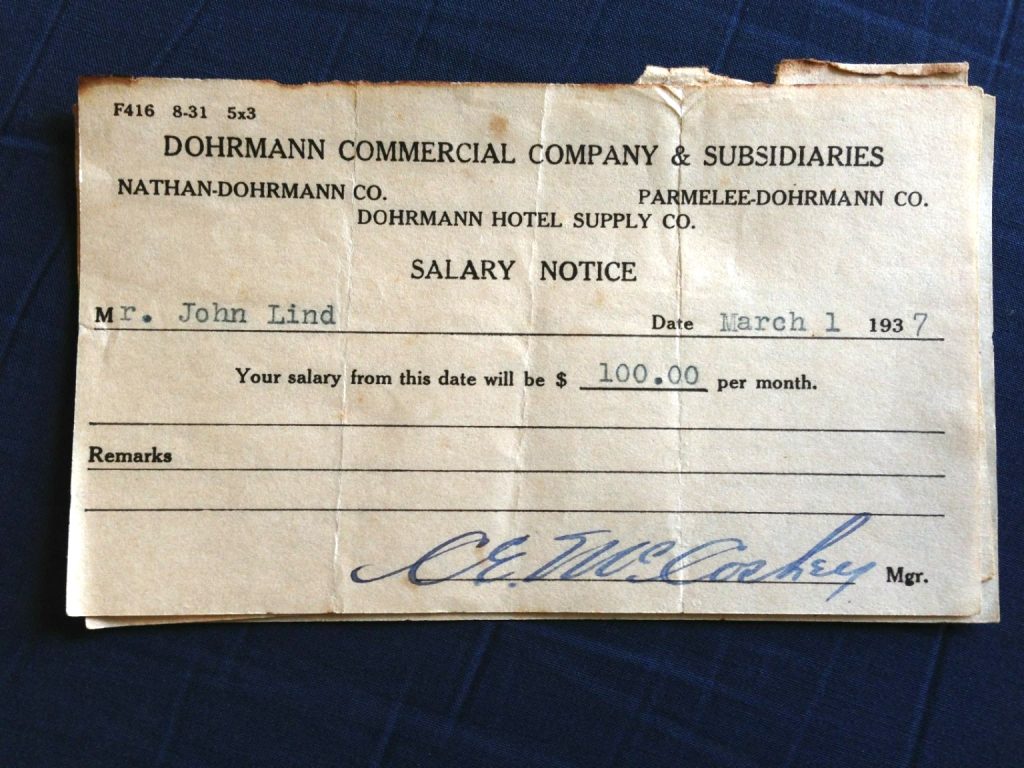My dad landed a job with Dorhmann Hotel Supply Company, a San Franisco-based company, in 1933. He wasn’t long out of high school. It was during the depths of the Great Depression, and jobs were in short supply. He was lucky to get hired as a stock clerk in Dohrmann’s Los Angeles store.
He then snagged a position as a delivery driver, and through a lucky break got into sales by volunteering to fill-in for a regular salesman who was going on vacation. He proved to be a good salesman, and the company promoted him. He did whatever he could to get ahead, and credited the Junior Chamber of Commerce and Toastmasters with providing new skills, confidence, and contacts which, along with his hard work, paid many dividends.
So when he received this salary notice, he had been working for Dohrmann for four years and was already a salesman. And all that work earned him $100 a month.
I wondered what food prices were like in 1937, and AI returned this answer. I guess $100 went a whole lot farther than it does today!
In Los Angeles in 1937, common food items were significantly cheaper than they are today. For example, a pound of hamburger cost 12 cents, a loaf of bread 9 cents, and a dozen eggs 45 cents. Other examples include:
Bacon: 18 cents per pound.
Sirloin Steak: 39 cents for 2 lbs.
Butter: 37 cents per pound.
Eggs: 45 cents per dozen.
Milk: 10 cents per gallon.
Potatoes: 10 cents for 3 lbs.
Sweet Potatoes: 10 cents for 6 lbs.These prices reflect the economic conditions of the Great Depression, when food prices were generally low.
Discover more from i L i n d
Subscribe to get the latest posts sent to your email.


Sweet Potatoes were undervalued even in 1937.
Wonderful , all the historic information your family collected.
Just for fun I used an inflation calculator from the web to calculate what that $100 would buy in 2025, it was worth $2,220.83. The ,$1,200 a year salary would be worth $26,649.96 today. Not good. People were really poor despite low prices. There followed a period where median incomes roughly doubled despite inflation and income inequality dropped (1950-1973). The good old days?
Thanks. That’s useful information.
Love that manager’s signature!! Back when people took pride in penmanship and actually knew how to write in cursive!
My great grandfather made a living and raised a reasonably big family way back in the early 20th century from his excellent and skilled penmanship. We still have a collection of his pen handles and dozens of different nibs. Relics of a long gone art form!
What strikes me is how expensive the eggs are relative to other proteins. They cost more than 3 lbs of hamburger or 2 lbs of sirloin. The butter price also seems wonky compared to the price of beef, at least by modern standards of relative cost. Butter (milk) and eggs can be collected from an animal many times over its lifetime, whereas an animal’s meat can only be harvested once. So why are these “renewable” animal-derived products so much more expensive than meat? I also associate the Great Depression as a time when most things were homemade out of economic necessity, it certainly seems like baking would not have been economical with those butter and egg prices (and the reportedly cheap cost of a loaf of bread).
Or is this a situation where the source data is perhaps questionable?